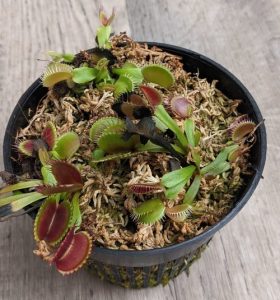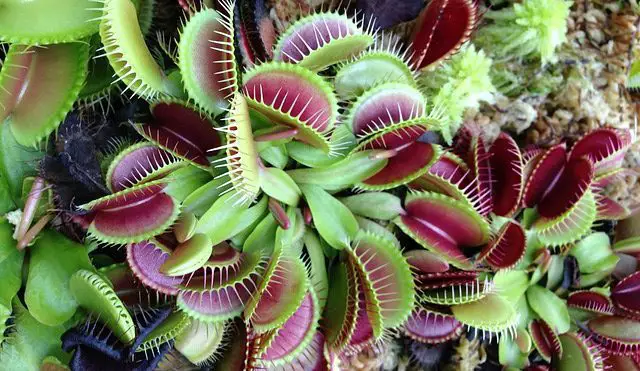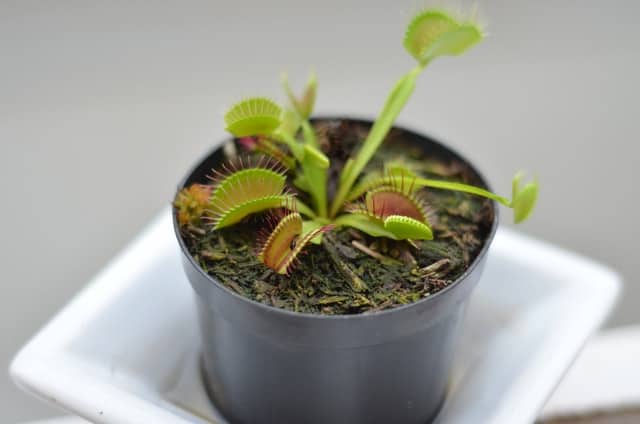Should you worry about black leaves in your Venus flytrap? Black leaves appear fairly often, sometimes they are normal and sometimes they are a sign of poor growing conditions.
Leaves in Venus flytraps continuously grow and wither as part of their growth cycle. However, when several traps in a Venus flytrap turn black, it can be a warning sign. An increasing number of dead leaves can be due to improper feeding, poor lighting, stress, or improper watering.
Here are the most common causes for leaves turning black in your Venus flytrap:
- Dormancy
- Natural life cycle
- Insufficient lighting
- Inappropriate feeding
- Wrong soil
- The use of tap water or bottled water
- Poor watering habits
- Unwanted stress
- Extreme temperatures
- Lack of humidity
- Use of fertilizers
In this article, I have made a list of all the most common causes of black leaves in Venus flytrap and I have included simple solutions to resolve them. Read it thoroughly to determine if the dead leaves in your plant are normal or if you should take action and modify your plant’s setup.
Possible Causes of Black Leaves
The leaves in Venus flytraps do not last forever. They sometimes wither. When they do, the leaves turn to a dark black color and dry out. The withering process can take several days or even weeks.
The leaves in a Venus flytrap turn black due to natural causes or due to improper care. Healthy Venus flytraps exhibit bright colors. The exterior of the traps is bright green, and the interior is bright burgundy. However, it is normal to observe black leaves within a healthy plant.
Read below to determine the cause of the status of your plant.
Do not be discouraged if you have made a mistake when caring for your Venus flytrap. We all have! Just be proactive and fix the problem right away. This article also helps you fix common care mistakes.

Venus Flytrap Turning Black Due to Natural Causes
Sometimes, Venus Flytraps turn black under entirely normal conditions. If you have not made any of the care mistakes we explain in the next section, then you might have nothing to worry about.
Leaf Cycle
Venus flytrap’s leaves open and close a limited amount of times before they wither. This process is entirely normal. Each trap might be slightly different, but they can open and close somewhere between five to ten times before they die. When the leaf starts turning black, a new trap should be spurring out.
All the traps in your plant will undergo this process. Do not get stressed about every single black leaf.
Usually, Venus flytraps grow 3 to 8 leaves at a time. I recommend monitoring the overall number of healthy leaves in your plant. It is normal to lose one leaf. But, if you notice several leaves are dying and the plant is not producing enough new ones, there might be a problem.

Dormancy
Venus flytraps undergo a dormancy process every year. In the winter, when temperatures drop, Venus flytraps will go dormant. During dormancy, black leaves are completely normal.
Depending on the time of the year, your plant might be experiencing dormancy. Venus flytraps start dormancy after been exposed to temperatures between 45 F (8 C) and freezing (32 F / 0 C) [1 ] for two to four weeks.
] for two to four weeks.
If you are uncertain if your plant is dormant or dead, the best you can do is wait until the weather warms up and your plant gets out of dormancy (hopefully). Dead Venus flytraps have a mushy texture and might smell. Dormant Venus flytraps on the other hand exhibit several black leaves, but they are not mushy and they shouldn’t smell.
Black Leaves in a Venus Flytrap Due to Care Mistakes
Black leaves can be a warning sign of improper care for Venus flytrap. Review the following items to confirm the black leaves in your Venus flytrap are due to natural causes.
Improper Feeding
It is exciting to feed a Venus flytrap. The feeding process is mutually beneficial for you and for your plant. Venus flytraps get extra nutrients, and humans become amazed by how the trapping mechanism works. However, some Venus flytrap owners get too excited about the feeding and mistakenly start killing the traps.
Improper Food: You can feed your plant with live bugs or dead bugs. Venus flytraps consume a wide variety of insects and arachnids. However, you should abstain from feeding your plant with any human food, such as burgers, raw meat, candy, and fruit.
Venus flytraps have evolved to consume bugs, but they are not able to digest human food. The plant will attempt to digest the human food you give it, but it will be unsuccessful. The Venus flytrap will spend lots of energy trying to digest that food but will give up eventually. When the plant gives up, it lets the trap wither.
Prey Size Mistake: Sometimes, the feed is too big for a Venus flytrap to consume. If the prey is too big, the trap won’t be able to digest it in an acceptable timeframe. Then, the plant will let the trap turn black and wither.
Do not feed your plant with large prey. A good rule of thumb is only to use insects that are 1/3 of the size of the trap. If you can’t find a small enough bug, feed bug pieces to you Venus flytrap.
The insects you feed your plant are just a supplement to boost their diet. You do not need to feed them giant bugs for them to live. Bugs are highly nutritious, and a single ant, for example, can provide enough nutrients for the month.
Feeding Frequency: Only feed one trap at a time and wait the appropriate amount of time between feedings. Feeding a single trap is enough for the whole plant. Once you have fed one of the traps, you can wait several weeks before the next feeding. A reasonable timeframe is to feed your plant once every 2-6 weeks. If you are in doubt if your plant is receiving too much feed, then wait until it has digested all previous bugs before the next meal. Also, during dormancy, avoid feeding your plant at all.
Not feeding your plant will also weaken it. Even though underfeeding won’t kill your plants and will most likely not cause any leaf loss, I recommend feeding your plant when necessary. When placed outdoors, Venus flytraps will feed themselves by catching prey. When placed indoors, your Venus flytrap will need your help! In that case, follow the previous instructions regarding prey size and feeding frequency.
Poor Lighting
Venus flytraps require lots of sunlight to thrive. In optimal conditions, they should receive 12 hours of sun a day. If your plant is receiving less than 4 hours of sunlight, it can be a big problem. Venus flytraps won’t die immediately when they suffer from light starvation, but they will weaken substantially.
When poor lighting occurs, the color of the traps sometimes fades. Also, you might notice some black edges in the leaves.
You can supplement the light requirement with artificial lighting. There is a wide variety of plant light options in the market. High Output fluorescent lights are suitable for Venus flytraps. Also, you can employ high power LED plant lights.
These are the grow lights I use to grow Venus flytraps. sundews, and pitcher plants indoors:
- Small plant light for 1-4 plants: https://amzn.to/2RsGlxr

- T8 LED light fixture for multiple plants (6500k Cool White): https://amzn.to/3uWoeh2

Wrong Water Source or Quantity
Venus flytraps require a lot of watering. The soil needs to be moist at all times. Also, you can’t water your plant with tap water or bottled water. Instead, use rainwater, reverse osmosis, or distilled water.
Using the wrong water or not watering enough will dry out the leaves. These mistakes can turn traps black and kill your plant very quickly.
If you used the incorrect water, repot immediately. Use new soil and make sure to use the correct type of water from now on. The minerals contained in standard tap water burn the roots of Venus flytraps.

Since Venus flytraps require a moist environment, I recommend using a saucer or plate to hold extra water. Like the image above, you can place the plant pot (with a drainage hole) in a shallow container filled with water. With this method, you always have a water reserve.
Wrong Soil
Improper soil can kill your plants very fast too. It might be counter-intuitive when you compare it with any other plants, but Venus flytrap needs nutrient-free soil. In the wild, they live in very poor soil. Therefore, they can’t handle any added nutrients or minerals.
Do not use standard soil; Venus flytraps can’t handle the nutrients. The plant will weaken and eventually die with the improper ground.
Employ carnivorous plant soil for Venus flytraps. Most growers use a combination of a type of moss, like Long-fibered sphagnum moss or sphagnum peat moss with a draining agent such as sand or perlite. The goal is to use a soil that does not contain any added elements.
If you have potted your Venus flytrap in the ground type of ground, remove it immediately. Employ the appropriate soil and water only with distilled water, reverse osmosis water or rain water.
Unwanted Stress
This Venus flytrap care consideration is often forgotten. Sometimes leaves turn black due to stress. The stress can be caused by people or by the environment.
Place your plant in a tranquil area without constant movement. Avoid spots where there is a flowing curtain or a strong fan. Motion can produce strain and ultimately cause your plant to lose leaves.
Also, do not touch your plant if it is not necessary. Avoid playing around with the traps and handling too much. Humans can also cause stress to the plant.
Use of Fertilizers
Excessive fertilizers can produce black leaves in most plants due to excessive salts in the ground. Venus flytraps have a low tolerance for fertilizers. Any type of fertilizing can make them lose leaves.
As a beginner carnivorous plant grower, it is best to avoid fertilizing Venus flytrap completely. Instead, you can feed your plant to provide additional nutrients. As an experienced grower, you can fertilize your plant by following these basic rules:
- Venus flytraps only need fertilizing during the growing season
- Avoid fertilizing if the plant has plenty of access to feed
- Fertilize Venus flytrap plants with weak foliar sprays
Extreme Temperatures
Venus flytraps are very resilient plants. However, extreme temperatures can make your plant lose leaves.
Cold Winters
Venus flytraps can live through cold winters close to freezing temperatures. However, the plant must not freeze completely. Avoid temperatures below 20 F.
Hot Summers
Temperatures over 100F can dry up Venus flytraps plants very quickly and cause leaves to turn black. During extreme summers you can:
- Bring your plants indoors
- Place them under partial shade, maybe under a shade cloth
- Limit their exposure to direct sunlight
Lack of humidity
In the wild, Venus flytraps live in mid to high humidity levels throughout the whole year. However, these plants can adapt to lower temperature indexes. If you live in an area that provides a regular 50% humidity in the environment, your Venus flytrap will have no issues adapting.
In arid climates, the lack of humidity can cause black leaves. Consider misting your plants to increase humidity and slowly reduce the misting over time.
Should You Cut Off Black Leaves in a Venus Flytrap?
You can certainly remove black leaves from your Venus flytrap. The black color from one leaf won’t expand into the next. But, dead leaves cause strain to the plant in the long term.
When to Cut the Black Leaves?
Venus flytraps, like other plants, can generate their food through the photosynthesis process. When a leaf starts turning black, it might be unable to capture prey. However, it is still able to help in the photosynthesis process.
In the beginning you might observe black spot in the edges of a trap or starting in the leaf base. Be patient, and do not remove the leaf right away. Instead, wait until they have wholly withered to take action. Once they have died, then you can trim them out.
The only exception to this rule, is when there is a dead bug inside a trap. Sometimes, due to improper feeding or maybe due to natural causes, a leaves starts dying while holding a bug. You can trim that leaves once it has start withering. Because the dead insect can attract bacteria or mold to your plant. Also, since the dead bug is still decomposing, it might emit unpleasant smells.
How to Prune a Venus Flytrap?
Use a sharp scissor to remove the black leaves. Follow these considerations to do it properly:

- Cut the leaves as close to the bulb as possible: Carefully, cut the dead leaves taking as much of it as you can. The more you take off, the less strain your plant will have to bear. Do not harm the bulb during the operation. That part of the plant is very delicate.
- Never pull the dead leaves: You can rip off part of the root and kill your plant if you pull the black leaves. Employ small sharp scissors instead.
- Do not activate any traps: Be patient when pruning your plant. Carefully grab the black leaves and cut them off. By all means, avoid activating any traps. You do not want to create more dead leaves for no reason.
- Be systematic: Preferable trim the black leaves all at once when several have accumulated to avoid stress. Also, keep an eye for dead leaves in poor locations, sometimes they are on the way of the leaves trying to find a place.
Benefits of Pruning Venus Flytraps
Remember, trimming your Venus flytrap is completely optional. In the wild, Venus flytraps produce black leaves fairly often and it doesn’t cause any problem. There, the black leaves decompose naturally over long periods. Still, pruning your plant can bring several benefits:
- Increase growth: dead leaves cause a strain in your plant. Remove the black leaves to let your plant focus on growing larger and increasing the number of healthy traps.
- Prevent Mold, Rooting, and Pests: Large quantities of dead foliage can increase the change of mold (this is how you can get rid mold) or bacteria .
- Clean Looks: Most people get very concerned when they spot black leaves in a Venus flytrap. In the end, black leaves do not look very appealing. Groom your plant now and then to give it a clean look and highlight the traps.
- Avoid Overcrowding: In the wild, dead leaves decompose a lot faster than at home or in a garden, due to more exposure to microorganisms. In a pot, dead leaves take months to decompose naturally. And besides the strain in the plant. The dead foliage can take up space and prevent new leaves from growing correctly.
Black Leaves vs Yellow Leaves in Venus Flytraps
Not all leaves turn black when they wither. Sometimes Venus flytraps exhibit yellow or brown leaves. Black leaves are in many cases harmless as they are due to natural causes. Yellow leaves, on the other hand, are a common warning sign or improper growing conditions. Yellow leaves eventually wither and turn black, but in the beginning, they start to decay by exhibiting a yellow or light brown coloration.
Similarly to black leaves, if you only spot one yellow leave in your whole plant. It might be insignificant. Instead, worry if you notice a pattern of yellowing leaves. Yellow leaves can be caused by improper soil, overwatering, root rot, and wrong water source.
Final Thoughts
Sometimes it can be stressful to be a beginner Venus flytrap grower. Venus flytraps are beautiful carnivorous plants, but they have very specific care requirements. Changes in growing conditions can affect these plants’ health and livelihood.
Generally, a new trap should grow for every dead one. Start to worry or take action if you notice an increase in black leaves on your Venus flytrap. The only exception is the dormancy period.
I hope you were able to identify the cause of the black leaves in your plant. If you are still unsure, consult our Complete Venus Flytrap Care Instructions . Verify your growth setup is optimum and continue improving it over time. Best of luck!
. Verify your growth setup is optimum and continue improving it over time. Best of luck!

